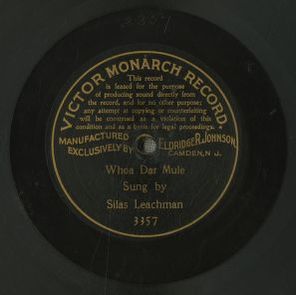Blackface minstrelsy, a nineteenth-century theatrical practice where white men would blacken their faces, dress up in racist exaggerated clothing and perform comic skits, variety acts, dancing and musical performances to their white counterparts. If the racially stereotyped mimicking of enslaved Africans working on Southern plantations wasn’t enough, we might be shocked to discover these performances were recorded and preserved in history for anyone to listen to. Should these recordings exist and be heard today? I would argue they should, for the simple reason that all must listen, view and comprehend this awful tradition and understand the impact it had on whites and their development of white identity, African Americans, and all people of color in the United States.
One part of these musical threaticies is “coon songs,” an aspect of ragtime music built on racial stereotypes of African Americans. These songs were often heard and observed as the centerpiece of Minstrel shows, and designed for the continuous humiliation and degradation of people of color. As you may have guessed, these best-selling hits could not exist without the performances of some of the world’s most talented and famous musicians at the time. A familiar name in the realm of Minstrel shows and “coon songs” stars was Silas Leachman, a Chicago-based politician and vocalist who specialized in the art of “coon songs.” These ragtime songs, wreaking of horribly racist African American dialects and stereotypes, were how Mr. Leachman made a living, and something all too common at the time. Mr. Leachman rose to popularity making his first recordings for the Chicago Talking Machine Company during the early 1890s. Later that same decade, he also started recording for Columbia Records. What I want you to listen to and further examine, however, is Mr. Leachman’s 1902 recording of “Whoa Dar Mule” by Victor Monarch Records.
Aside from the racist text, it is difficult to listen to this recording and somehow conjure up a scholarly opinion of the music, if any at all. A syncopated ragtime, rhythmic style is common in a number of these “coon songs” so it is challenging to elaborate on their originality based on the individual song. A recording from the Library of Congress’ National Jukebox may help your ears understand what I’m trying to describe:
Link to song here: https://www.loc.gov/item/jukebox-5667/
Regardless of the obviously stereotypical lyrics, we should be more concerned with the racist dialect that is used in concert with the exquisite African American tradition of ragtime music. The contribution of the art forms of African American musicians from genres such as: spirituals, jazz, ragtime, blues, rock ‘n’ roll, soul, pop and rap, deserve respect and acknowledgement. These contributions should be embraced and amplified, never diminished. This likely was not a part of Mr. Leachman’s mindset when he committed to becoming, and being compensated, as a major vocalist for Minstrel shows and their “coon songs.” Nonetheless, as Eric Lott declared in Love and Theft: Blackface Minstrelsy and the American Working Class, “Every time you hear an expansive white man drop into his version of black English, you are in the presence of Blackface’s unconscious return.” This is a warning to stay vigilant when you are inclined to turn away and ignore mockery and other aspects of marginalization that may not directly impact you.
When you degrade one you degrade us all. Sadly, elements of this behavior are ever present in society today. Irrespective of your lived experience and racial identification, this music is a reminder of how far from we were then, and how far we remain, from living up to the American ideal of equality for all men and women. Because it also offends all moral and religious teachings of compassion and love for our fellow people, we are compelled to watch, listen and dialog about the impact of these works as we raise children in a society that is based on a belief in the superiority of the white race. This exploitation of African Americans, while maybe not done in mainstream circles today, must be addressed by all of us to prevent giving unconscious approval to the white supremacy in our midst.
Works Cited
“Blackface: The Birth of an American Stereotype.” National Museum of African American History and Culture, 22 Nov. 2017, https://nmaahc.si.edu/explore/stories/blackface-birth-american-stereotype.
Leachman, Silas F. Whoa Dar Mule. 1901. Audio. Retrieved from the Library of Congress, <www.loc.gov/item/jukebox-5667/>.
Lott, Eric. Love and Theft: Blackface Minstrelsy and the American Working Class. Oxford University Press, 2013.
“What Were Coon Songs? – May 2005.” Ferris State University, https://www.ferris.edu/HTMLS/news/jimcrow/question/2005/may.htm.

